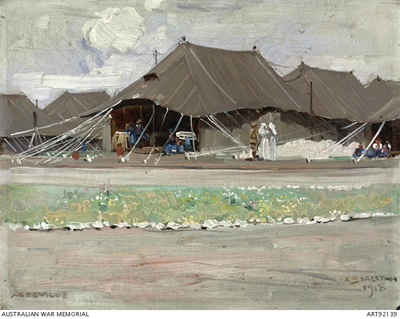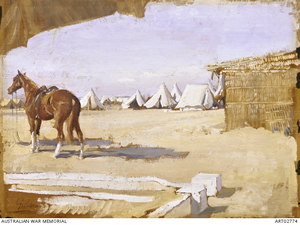Visual arts Stage 3
Overview

Abbeville by Arthur Streeton, 1918, depicts tents at the 3rd Australian General Hospital
©Public domain (AWM ART92139)
Students investigate a range of techniques to explore how war artists created their artworks. They create an artwork inspired by the works of a war artist. Students also view images of underwater First World War wreckage and consider the effects of time and water. They explore filters and effects by digitally manipulating a selection of images.
Teaching and learning activities

Moascar, from Major 'Banjo' Paterson's tent George Lambert, 1918
©Public domain (AWM ART02774)
How do war artists portray the subject matter of war?
1. War artists
Moascar, from Major 'Banjo' Paterson's tent by George Lambert depicts the Remount Camp at Moascar, North Egypt. The view of the camp is from Major 'Banjo' Paterson's tent. Andrew Barton ('Banjo') Paterson, poet and journalist, was in charge of the Remounts Section, where the horses and mules from Australia were broken in and trained.
View the The Art of Australia Episode 2 from 3:00–7:15 about art during the First World War, specifically the works of Lambert, Waller and The ANZAC Book.
Discuss the similarities and differences between the artworks of official war artists such as Arthur Streeton and George Lambert.
Investigate a range of techniques to explore how war artists created their artworks.
Sources:
Australian official war artists
Create an artwork inspired by the works of a war artist.
2. Underwater wreckage
How can the effects of time and water change the appearance of objects and how can these be represented in artworks?
View the gallery of images of underwater First World War wreckage on the UNESCO website: Underwater Cultural Heritage—Centenary of World War I.
Look at the way new things grow out of the wrecks at these heritage sites. Describe the colour of the sea, the shapes and effects of rust.
Find out about the ecology of these sites such as the fish colonies and the sea grasses growing there.
Explore filters and effects to change the image by digitally manipulating a selection of images.
Consider and discuss how these images combine water and war, growth from decay, and rebirth and recycling.
Create mixed media artworks inspired by UNESCO images of submerged war wreckage using digital, fibre and/or recycled materials.
Learning concepts
These additional questions can be used for discussion or further investigations.
Challenge
War artists were commissioned to create drawings and artworks in the field during the First World War. What challenges would this commission present to the artists?
Change
Items such as diaries, official records, photographs, objects, artworks and wreckage provide evidence of the First World War. How does underwater wreckage change over time?
Community
What purpose do artworks created by commissioned war artists serve in the community today?
Syllabus links
VAS3.1 Investigates subject matter in an attempt to represent likenesses of things in the world.
VAS3.2 Makes artworks for different audiences, assembling materials in a variety of ways.
VAS3.3 Acknowledges that audiences respond in different ways to artworks and that there are different opinions about the value of artworks.
VAS3.4 Communicates about the ways in which subject matter is represented in artworks.